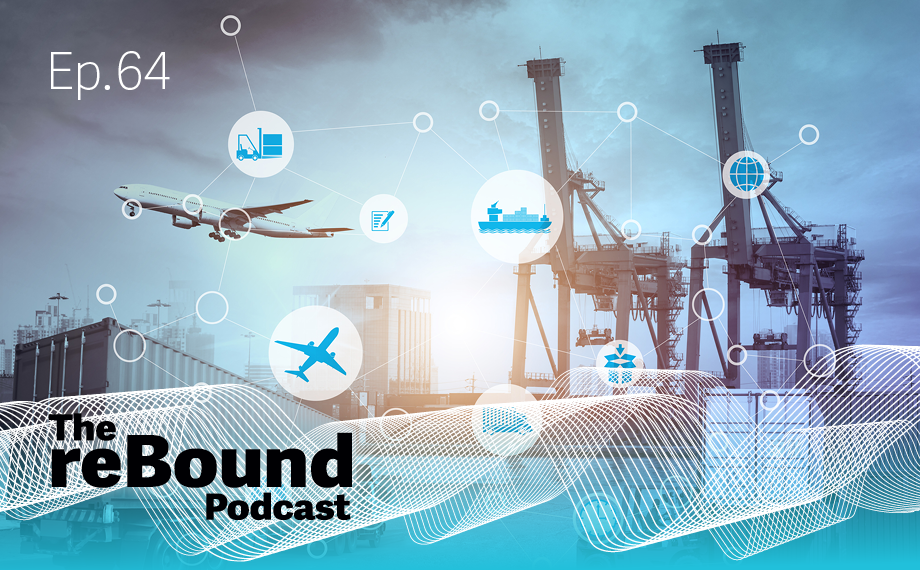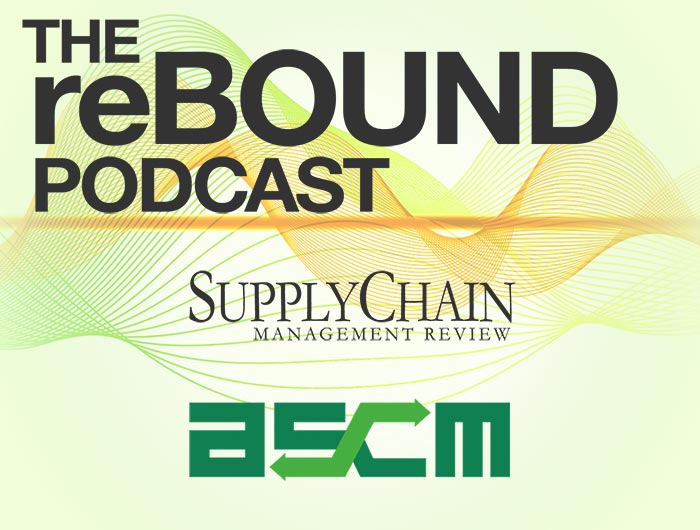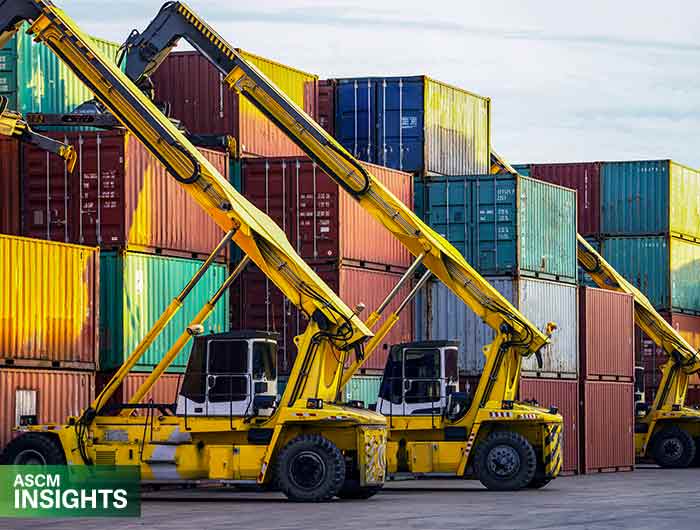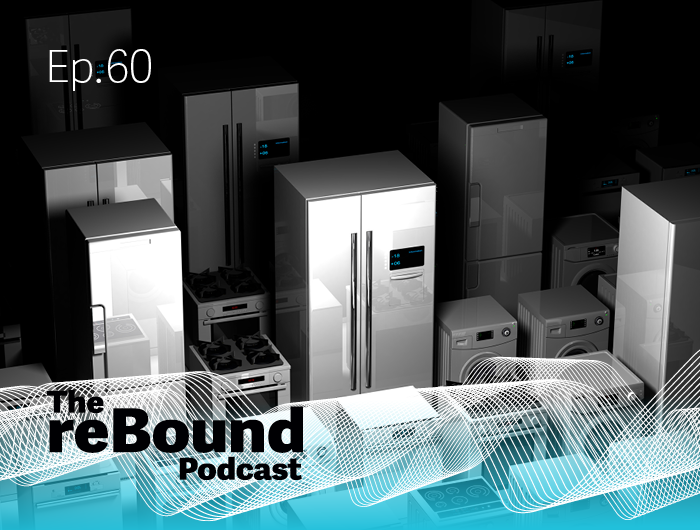Bob Trebilcock: Welcome to The Rebound, where we'll explore the issues facing supply chain managers as our industry gets back up and running in a post-COVID world. This podcast is hosted by Abe Eshkenazi, CEO of the Association for Supply Chain Management, and Bob Trebilcock, Editorial Director of Supply Chain Management Review. Remember that Abe and Bob welcome your comments. Now to today's episode.
Bob: Hello, and welcome to today's episode of The Rebound, innovation in the 3PL supply chain. I'm Bob Trebilcock.
Abe Eshkenazi: I'm Abe Eshkenazi.
Bob: Joining us today is Yujie Su. Yujie is Head of Product Innovation at Maersk, one of the world's leading shipping companies and 3PLs. Yujie, welcome.
Yujie Su: Hi, everyone. I'm very happy to be here, and thanks for having me.
Bob: We're glad to have you. This is a great topic for our audience. I had a chance to learn a little bit about Maersk at Gartner last year, so I'm really excited about talking about this one. If you think about it, it's been 17 years since Apple introduced the iPhone and began its meteoric rise from a maker of boutique computers to one of the most valuable companies on the planet. One of the lessons from Apple's success is that it pays to be an innovator. A corollary to that lesson is that innovation is hard to do. Even Steve Jobs didn't always get it right.
I think today every company worth its salt is looking to get some of that innovation action. In the supply chain, Maersk is one of the companies that is investing in innovation in a major way to maintain its competitive edge. That's what we're going to talk to Yujie about today. Yujie, let's get started. Can you tell us a little bit about your role as head of product innovation at Maersk? What does the innovation team do, and what does your role encompass?
Yujie: Yes, absolutely. To start with, I want to discuss a bit about this innovation center concept that's developed in Maersk for about a couple of years now. I think we started three years ago as an innovation center. The company has gradually, very quickly actually, realized how important innovation is in the supply chain space. We quickly elevated from a North American organization to a global organization overseeing all the logistics and services innovation that Maersk is encountering these days.
As a team, our purpose is to do the radical thinking that to think about the technologies and what's out there could actually make a change to our industry, rather than the small changes where we have the process excellence these teams are doing a great job of. As a product innovation team, what we do is actually to look at end-to-end supply chain and to provide integrated solutions to our customers versus today in supply chain where customers have to prescribe every leg of the transportation in order to get the final destination. That is essentially what product innovation in Maersk entails and what we do in the team.
Abe: Yujie, I'm sure everybody has a different vision of what innovation means to them. At Maersk, I'm sure not a lot of people would associate innovation with the movement of the containers and the ships. Give us a sense of, how do you define innovation at Maersk.
Yujie: Yes. For us, innovation essentially means two things. The first of all, as we're all very aware of, the supply chain and the logistics industry in general is not at the front end of technology, to be very honest. A lot of technologies that are out there for other industries that has not been applied to supply chain or to Maersk, that's a source of innovation for us, for our team, for Maersk.
The other side of the innovation is the real cutting-edge technology that's emerging every day. We see it as a big potential for supply chain, for logistics in general as well. Then we want to be participating in developing that game, futuristic projects to invest today, and when the technology is mature, the use case is mature, we are already in the game. That's two sides of the innovation projects we are encountering and taking in in our teams.
Bob: Yujie, a moment ago, you mentioned your innovation center and you use the phrase radical thinking, which I really like, and hoping we can expand on that a little bit. My understanding is at the innovation center, you've got to focus on what you call three pillars of innovation and then their supporting functions. They're research and development, digital innovation, and product innovation. Then those pillars are supported by three functions, solution scouting, data sourcing, and implementation and deployment. Let's explore those a little bit, and then after that, I'm going to talk about one specific transportation project your team worked on. Let's start with the R&D function. What drives R&D and how do you develop potential solutions? Do you have a fail-fast mentality?
Yujie: Yes. For us, R&D, research and development, really means automation, autonomous, and advanced robotics. For us as a logistics provider, we don't necessarily want to have a science lab to develop all the solutions ourselves. How we drive and design these innovation solutions are we relying on the technology providers, which most of the cases are the startups. We're collaborating very closely with venture capital companies who are investing in the startups to give us a pipeline of mature enough startups for us to work with.
Then on the other hand, the solutions that we are bringing up and the problems we're dealing with are coming from either internal business units. For example, we have transportation business units and they have issues with their EV charging, for example. Can you bring us the EV chargers that does not necessarily need to have downtime, for example, right? These are some solutions with problems we encounter.
The other side of the problems we encounter are coming from customers. One customer came to us saying my transit time is very unstable. Sometimes my goods arrive 40 days from Asia, some other times it's 120 days. Can you do something to change it? That's essentially where our ideas are coming from and how we source the innovation solutions in that space.
Abe: It's interesting that you're describing how it's done and where do you source that supporting technology. Especially today, you're often seeing emerging technologies from startups and variety at different locations. How do you embed that within your innovation wheel?
Yujie: We are very closely embedded into the startup ecosystem. We intentionally built an ecosystem around us because we know innovation is not going to happen in a vacuum. We cannot be a team of 20, 30 people sitting here in corporate and then innovate the world. That's definitely a no-go. What we do is that we attend a lot of startup conferences and we go to our venture capital partners' conferences where they present their portfolio companies. We also are reached out by many startups on a daily basis where we have 15, 30-minutes pitch with them to understand what technology is offering to us and it solves some of the problems we have in our daily business life.
Bob: The second pillar is digital innovation. That sounds a lot to me like digital transformation, but can you explain to us in your world, what is digital innovation? Then how does it fit with that broader concept of digital transformation?
Yujie: Yes, sure. For us, digital innovation is a lot more than digital transformation. To me personally, digital transformation has to happen before the digital innovation can happen. The reason for that is that digital innovation for us means machine learning, computer vision, advanced analytics using the data. If you have everything on paper, then essentially, these digital innovation capabilities, you're not able to get started, right? Some sort of digital transformation has to happen within the organization. You have to have data somewhere. That's when you start to use the data to do the machine learning, to do the artificial intelligence and computer vision analysis.
That's essentially what our digital innovation is doing and the projects are about. It's built on digital transformation, which Maersk has been doing for a lot of years already, but it's a lot more and a lot more advanced than digital transformation.
Abe: Yujie, that's really interesting because one of the things that we're struggling with in the industry is access to relevant, timely data, and it sounds like you've been working on it for a while. Obviously, you don't work in the supply chain unless you have accurate data. How do you go about identifying the sources of data to ensure that you're getting not only the timely data, but it's accurate? Then how do you bring that data in as needed? Because obviously, there's a whole lot of data points. How do you ensure you're getting the right data point at the right time?
Yujie: That is a very good question and a very interesting one. I'm sure other big companies, other people who work for the big companies like myself working in Maersk, would have the same feeling that the data is all over the place. As a global company, and we acquired so many companies along the way, you can imagine our data sitting in multiple different systems, both geographically speaking all over the place, like entire world, and also in the different systems.
What we have a principle to counter this problem is that we are building a data lake starting in North America. That's where this project initiated, where we have the systems, multiple systems, putting the data into what we call a data lake, ingesting the data there in order to have the access, to give the access to everybody who is in the organization to slice and dice the data as how they want.
It sounds very simple, but it is a very complicated process because each system is somehow linked to another. Let's say from a drayage operation to a warehouse operation, you have some sort of connection because you're dealing with the same containers. At the same time, you have many, many different parameters because you each focus on different area of business. For the overlapping part, the systems identify it differently for the same container. Sorry, how do you match those data points when they're talking about the same thing is the tricky part of this project where we spend a lot of time and resource to do. We're not 100% there, but we're getting there to have the right data into the data lake so people can have access and slice and dice the data how they want.
Bob: Yujie, the last pillar is product innovation. That sounds like the process from when an idea developed in R&D matures enough to where it might be a solution for a Maersk store or Maersk customer. Can you talk about that process or how something evolves from idea in R&D to, hey, this could work as a product?
Yujie: Yes, absolutely. I'll give you an example exactly describing the concept of product innovation and how everything comes together. R&D, autonomous automation, and digital innovation, machine learning, all these fancy stuff has to make sense for our customers. We're not innovating for the fun or looking cool of it. It essentially has to be embedded in the offering, in the solutions we give customers. That's what product innovation essentially is about.
One good example is that we, a couple of years ago, tested an IoT device to track the condition of the cargo and the GPS of the real-time location of the cargo. That project was tested under the R&D arm because it's something physical. We used thousands of shipments to test these trackers, and they work perfectly. Today, actually starting from the beginning of last year, we started to offer customers an integrated product where we bring their cargo from the factory in Asia all the way to their DC in North America, using that tracker to track the location and the condition of the cargo. Also, the theft prevention part is very interesting in that project.
Our customers are paying per container rate for the integrated logistic solutions. That's an example of how we bring a solution, a single solution, into an integrated product or a solution that's offered to our customers.
Abe: Yujie, one of the challenges that we have is taking it from concept, from pilot, to pilot, to implementation, and what's necessary to scale it up. How do you take new innovation live given the breadth and the depth of the work that you do with your clients?
Yujie: That's another very interesting topic we constantly discuss and we learn along the way. For us, we have encountered in the past when we first started this journey, that a great innovative idea which are tested successfully cannot be brought further if you hand it over to the business right away after the POC, the proof of concept. The reason for that is because it's not only to apply a solution, it's not plug and play. It's sometimes, a lot of times, to change the mentality of people, to change the way of working, to change how you manage things on a day-to-day basis where people are familiar with. Those things are not necessarily transferable in one email.
To tackle that, what we come up with is that where we have a supporting function called implementation and deployment. For every proof of concept we have tested successfully within the innovation center, we will have an implementation deployment team sitting between us and the engineering team and the business team to hands on tell them how to deploy this development of innovation solutions. Up to five cases, five deployments in the innovation center is heavily involved into this to ensure the transfer of knowledge and experience and to train the mindset of how things should be done and to troubleshoot any issues that along the way which we have already encountered during the POC, but not necessarily for the business people who are seeing this for the first time.
By doing these five applications, we believe that's enough time to transfer the knowledge and experience of applying an innovative solution to the actual business. After that, we have the confidence that our business people have enough tools and knowledge to take this application further and scale on a global level.
Bob: Yujie, I want to take you back to the transportation innovation you mentioned a moment ago. I think it's the one that I learned about at Gartner last year, so if I'm wrong, please correct me. It's something that I think you were working with Fry, right?
Yujie: Yes, that's right.
Bob: Okay, so I found that a really fascinating one and I know Abe's going to have a question about some of the counterintuitive findings that you got from that, but talk to us a little bit more about first how it came about and then what these sensors do both on the cargo ship but then also on the trailer, and then Abe will finish it up with a little bit more detail.
Yujie: Yes, sure. This project came about that the customers' increasing need for visibility of their cargo, which in the logistics space was not given back then. This project was about two years old, I believe. That's where we started to scout for the solutions that can potentially provide such tracking capabilities, not only on the location perspective but also on the condition, which means temperature, for example, humidity, for example, which are very important for some leather shoemakers, for example. They care about humidity cannot be too high or too low, that will jeopardize the quality of the shoes, for example. That's something very interesting we learned along the way as well. Bob, did you say that counterintuitive learnings of this project just now?
Bob: Yes, Abe will get to that in a moment because one of the things we talked about was not the ship transit times but the trailer transit times. Can you talk a little bit about the ship transit times or what they are? On that other end, you learned things on the ship side about how products move just to get on the boat, right?
Yujie: Yes, absolutely. Talking about that project, there is a very interesting finding, Bob. That's what you learned and discussed with the areas as well I've got there. What happened was that we took about 2,000-3,000 shipments from one of our customers who's shipping inland on the 53-trailer from our California facility to their Memphis distribution center. On a Google Map, if you put these two destinations, there are two routes spitting out. One is slightly on the north, one is on the south. For the sake of it, we call it North Route and South Route.
The interesting thing is that the Google Map will tell you on the North Route, it will take 32 hours by driving, and on the South Route, it will take 34 hours by driving. This is obviously without stops or anything, right? Northern Route is slightly shorter than Southern Route. After the POC of thousands of shipments, what we found out is that on the Northern Route, people take the transit time is 6 days plus minus 2. On the Southern Route, funnilly, the transit time is shorter and more reliable, it's 5 days plus minus 1. We wonder what happened, why you take more transit time on the shorter route and more unreliable on the shorter route.
In order to find that out, we called our drivers to ask them what exactly happened. What we found out is on the Northern Route, the drivers take more stops along the route. We asked them why. They told us that because the parking lot, the rest lot for the drivers on the Northern Route is smaller, and it's a more congested route because most people would pick the shorter route. They don't necessarily trust that when they are supposed to stop, they can find a place to stop. They start searching for the stopping spot long before they have to stop, which means they'll stop much earlier than the time they're allowed.
On the Southern Route, it's different because people are able to trust that at the spot where you're supposed to stop, you can find a spot because the parking lot is bigger, and there is less density on this route. That's why people don't necessarily go and find a place to park before they have to, so they stop much less along the Southern Route, which leads to essentially the result that on the shorter route, you take longer time and it's more unreliable, and the longer route, you take less time and it's more reliable. This insight is very interesting to us and it gives us the knowledge and experience in how to guide our drivers going forward which route to take. That's the funny thing out of that project we have not expected.
Abe: Yujie, that is really interesting. When you take a look at the learnings that you had and some of the not-so-easy answers are coming through the innovation, as you look back on it, are there technologies or activities that you wish you would have accelerated a little bit and some that you said, you know what? We should have paused on this one. As you look back, give us a sense of what you learned and what you could do better.
Yujie: That's a very good question. One thing I would definitely accelerate is the ability of getting the right data to the right place. We have many great projects. We're cooperating with the top minds of the industry. Some projects, for example, we're working with MIT. It's a great concept, great on paper, but the bottleneck has always been to get the data ingested to the system. I have found that being a bottleneck for a lot of projects of the innovation center today. That's something, if I could go back, would definitely accelerate. Maybe as a cornerstone of all projects, you should get your data clean at the beginning of any project. That will make a lot of process much, much easier and much, much faster.
Abe: Yujie, we could probably continue on the conversation, especially with all the turmoil that's going on around the world. You have your hands full, obviously. Really interesting and the innovation and all the work that you're doing. Thank you today for sharing it with us. That is all the time that we have today. A special thanks to our guest, Yujie Su from Maersk, and thank you for joining. We hope you'll be back for our next episode for The Rebound, I'm Abe Eshkenazi.
Bob: I'm Bob Trebilcock.
Abe: All the best everyone, thanks.
Bob: The Rebound is a joint production of the Association for Supply Chain Management and Supply Chain Management Review. For more information, be sure to visit ascm.org and scmr.com. We hope you'll join us again.



